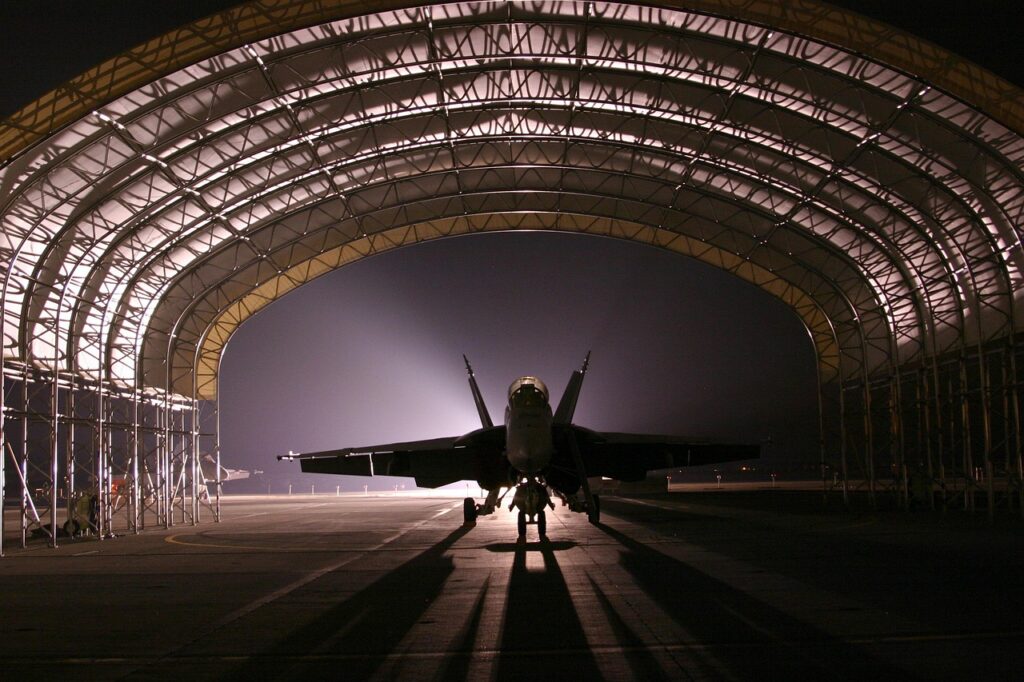You all probably know that steel is one of the, if not the, best materials to use in construction. People have been using it for their homes, garages, carports, barns, and many other structures. But did you know that it is also the best material for constructing hangars?
The Unique Demands of Aircraft Hangars
Aircraft hangars are more than just oversized garages for planes. These structures function as vital components of aviation operations, serving multiple roles such as providing protection from the elements, accommodating maintenance activities, offering secure storage, and facilitating operational logistics for a wide variety of aircraft. The design and construction of such a facility must meet demanding standards. It requires materials that are exceptionally strong, economically viable, and capable of withstanding severe weather conditions. Among the array of construction materials available in the modern industry, steel rises as the most practical and beneficial solution for meeting these challenges.
The expectations for a hangar extend far beyond its structural shell. Hangars must be designed with the flexibility to accommodate various aircraft sizes and support complex workflows. Therefore, the selection of a construction material is crucial to ensuring safety, efficiency, and adaptability. Steel is favored in aviation infrastructure for its unique combination of strength and malleability. Its proven track record in both military and commercial aviation speaks to its reliability. The material’s durability under environmental pressure and capacity for architectural freedom make it a standout option for even the most specialized hangar requirements.
Steel’s dominance in hangar construction stems not only from its physical properties but also from its adaptability to large-scale architectural projects. Aircraft hangars often feature expansive floor areas with minimal internal supports, which calls for a building material capable of spanning great distances without compromising structural stability. Steel fits this profile perfectly. In scenarios where construction speed, cost control, and long-term performance are essential, steel continues to prove itself as the optimal choice for aviation hangars.
Strength and Structural Integrity
Aircraft hangars must support massive roof spans without the need for internal columns that could obstruct aircraft movement. This is where steel’s superior strength becomes essential. It allows for large, unobstructed spaces by enabling long spans and open layouts. These clear-span interiors are crucial to the functionality of the hangar, especially when accommodating large aircraft or multiple smaller aircraft within one structure.
Steel also handles both compression and tension well, giving it a structural versatility that other materials like wood or concrete cannot match in large-scale constructions. It provides exceptional load-bearing capabilities, which are critical for supporting the weight of roof-mounted equipment such as lighting, ventilation systems, and fire suppression units. The structural integrity of steel ensures that hangars remain safe, reliable, and serviceable over decades of use.
Durability Against Weather and Environmental Stress
Hangars are exposed to a wide range of environmental factors. From heavy snow and rainfall to high winds and seismic activity, hangars must be built to withstand the elements. Steel naturally resists these environmental pressures. It does not warp, crack, or split like wood, and it can be treated to resist corrosion, making it ideal for long-term use in diverse climates.
In coastal areas or humid regions where rust can be a concern, galvanized or coated steel offers additional protection. The inclusion of rust-resistant treatments ensures that hangars remain structurally sound even when subjected to salty air or moisture-rich conditions. Steel is also fire-resistant, which significantly enhances the safety of both the structure and the valuable aircraft it protects.
Speed and Efficiency in Construction
Steel hangars are often prefabricated in controlled factory settings before being assembled on-site. This prefabrication process minimizes construction time and reduces the risk of weather-related delays. The pieces arrive ready to be bolted or welded together, leading to a much quicker build compared to traditional construction methods.
In scenarios where rapid deployment is required, such as in military or emergency response operations, steel’s construction efficiency becomes even more valuable. The ability to quickly erect a fully functional hangar can support operational readiness and mission success. Time saved in construction also translates to reduced labor costs and earlier usability, which benefits project budgets and schedules.
Cost-Effectiveness and Long-Term Value
The initial investment in steel may appear higher than some other materials, but its long-term value proves superior. Steel hangars require less maintenance, have longer lifespans, and face fewer repair needs over time. The durability of steel minimizes the risks of structural failure or degradation, resulting in fewer disruptions and lower operating costs.
Insurance premiums for steel buildings can also be lower due to their fire resistance and strength. Combined with the minimal maintenance required, these savings add up significantly over the lifetime of the structure. Steel is also recyclable, and many hangars today are built using recycled steel, reducing environmental impact and contributing to sustainable building practices.
Flexibility in Design and Customization
Each hangar serves specific needs based on the aircraft it houses, the climate of the region, and the operational requirements of the organization. Steel provides exceptional design flexibility, allowing architects and engineers to tailor hangar dimensions, configurations, and features to match exact specifications.
From single aircraft storage units to multi-bay complexes with administrative offices, workshops, and fueling stations, steel enables the seamless integration of diverse functionalities. Clear-span steel buildings can be expanded easily as aviation fleets grow. Doors, ventilation systems, insulation, and lighting can all be customized to enhance both performance and comfort.
Steel’s flexibility also makes it easier to design hangars with large vertical clearances, wide door openings, and advanced automation systems. These capabilities are vital in modern aviation operations where technology and efficiency go hand in hand.
Sustainability and Environmental Benefits
As the aviation industry becomes increasingly aware of its environmental footprint, choosing sustainable materials for infrastructure becomes a priority. Steel is one of the most sustainable building materials available today. It is 100 percent recyclable without losing its structural integrity, and it can be repurposed multiple times over its life cycle.
Many steel manufacturers now use energy-efficient processes that reduce emissions during production. Using steel for hangars aligns with green building standards and can contribute to certifications such as LEED. The energy efficiency of steel buildings can also be improved with modern insulation and roofing materials, reducing heating and cooling needs inside the hangar.
Safety and Security Advantages
Hangars often house multi-million dollar aircraft and sensitive equipment. Ensuring their protection is paramount. Steel structures provide a higher level of security compared to wood or other light-frame materials. They are more resistant to break-ins, vandalism, and fire hazards.
Steel hangars also offer excellent protection from external threats, including high-impact storms and earthquakes. Their engineered strength reduces the risk of collapse and can safeguard both personnel and aircraft during emergencies. For military applications, steel hangars may include reinforced zones for added protection against blast or ballistic threats.
Adaptability for Modern Aviation Needs
Aviation is a dynamic industry. Aircraft models evolve, equipment needs shift, and operational requirements expand. Steel buildings can adapt to these changing needs with minimal structural overhaul. The modular nature of steel construction makes it easier to retrofit hangars for new technologies or different aircraft sizes.
This adaptability is particularly important for facilities that support mixed-use functions. A steel hangar can be partitioned into separate sections for storage, maintenance, and administrative tasks. Changes can be made as needed without compromising the integrity of the overall structure. This level of adaptability ensures that hangars built today remain useful and relevant in the decades to come.
Conclusion: Steel Delivers What Hangars Require
From structural strength to architectural flexibility, steel offers everything needed for high-performance hangar construction. It meets the unique demands of the aviation sector through its unmatched durability, rapid build potential, and long-term value. As the industry continues to grow and diversify, steel remains the best material to keep pace with evolving needs.
Aircraft hangars are mission-critical facilities. They protect valuable assets, support essential operations, and stand as testaments to engineering precision. Using steel ensures that these structures are as reliable, secure, and forward-ready as the aircraft they house. For any organization planning a hangar, choosing steel is not just a smart decision; it is the best one.

